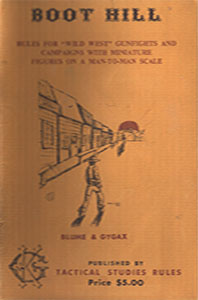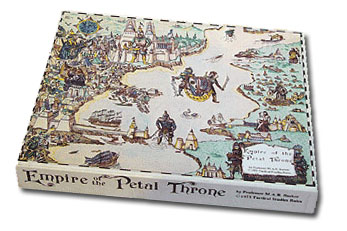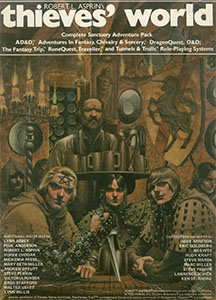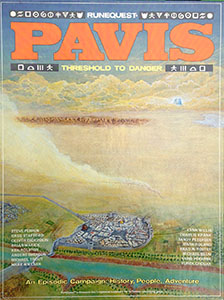This will be a rather eclectic round-up of some additional old school city supplements I surveyed while doing my urbancrawl research.
BOOT HILL
 The original Boot Hill was primarily a wargame for running gunfights in the Wild West with a light roleplaying element draped over the top of it. (This is probably because it was released in 1975 and people still hadn’t quite figured out the whole “roleplaying game” thing.)
The original Boot Hill was primarily a wargame for running gunfights in the Wild West with a light roleplaying element draped over the top of it. (This is probably because it was released in 1975 and people still hadn’t quite figured out the whole “roleplaying game” thing.)
It does contain some advice on setting up a town: “Each building used (excluding the small ones with half-moons cut into the doors) in a town must have a complete plan drawn for each of its floors, including any cellars or basements.”
Hmm… Probably not that useful.
EMPIRE OF THE PETAL THRONE
Also released in 1975, M.A.R. Barker’s Empire of the Petal Throne had a much firmer grasp on the whole “roleplaying game” thing. It also includes some intriguing guidelines for urban-based play (exactly the sort of stuff missing from OD&D and AD&D):
- “Initial Encounters in Jakalla”, which serves as a random generator for people looking to hire the PCs and the missions they want to hire them for.
 “Erecting and Buying Buildings”, which calls to mind Arneson’s Blackmoor as described in the First Fantasy Campaign.
“Erecting and Buying Buildings”, which calls to mind Arneson’s Blackmoor as described in the First Fantasy Campaign.- “Advertising”, which the City State of the Invincible Overlord was also providing guidelines for almost simultaneously. (It seems likely that this focus is the direct, organic response to actual players.)
- “This will require (a) a terrain map of the area, (b) a surface map of any city or cities to be developed, and (c) maps of the Underworlds of those cities. A detailed terrain map of a single hexagon can also be drawn to scale, if the details of a particular region are required (e.g., for a military campaign).”
THIEVES’ WORLD
The Thieves’ World boxed set was released in 1981 as a generic supplement based on the series of fantasy anthologies and featuring stat blocks for a couple dozen different RPGs. Let me lead off with a quote from designers Yurek Chodak, Steve Perrin, Greg Stafford, and Lynn Willis:
While fighting, arguing, and other sorts of adventuring are important and have their place, all adventures conclude, and even the greatest adventurer goes home to spend his profits. If he is like most of us, he will try to impress others with his success. Those other people are found in cities, as are rooms, markets, taverns, libraries, and gyms.
The city is the natural home of every adventurer. The ebb and flow of city life gives opportunity for every type of character. A city is the only environment proper to a full-time thief. Only in cities do many strangers meet, and only in cities is information plentiful. The bigger the city, the more readily are exotic items found or sold.
Earlier I described the early Judges Guild’s approach to cities as a mish-mash of color, information gathering, and carousing. This quote seems to sum it up elegantly.
 Also of interest is this quote:
Also of interest is this quote:
Contrary to most fantasy role-playing games, the gamemaster should not try to run too many players at one time while running a city. We find a mix of 1-2 players to be optimal, with 4 being a very real maximum even with experienced players. If more players are run, someone will always be bored, since the G.M. can only interact with one player at a time. Conversely, the number of characters is not particularly important, as only one character can be active per player at any given moment.
The notable assumption here is that city-based adventures will typically feature characters acting independently instead of collectively as a group.
In terms of practical material, what interests us particularly in Thieves’ World is the rich and robust encounter system. The tables are designed to be used every 10-15 minutes (a timeframe which appears to refer to the real world and not the game world).
A significant number of encounters start with “accidentally bumps…” This represents the jostling the characters would receive in any busy street and helps to prevent thieves from becoming too obvious.
The encounter tables are then broken down by neighborhood and some specific regions within each neighborhood are given specialized tables. The exact procedures for generating encounters are not particularly notable, but the sheer scope of the system is an escalation of the old Judges Guild methods (which the Judges Guild was simultaneously abandoning with City State of Tarantis).
Also of note are the Business Generation rules, which the GM can use to randomly stock the largely unkeyed map of the city.
PAVIS
Released in 1982, the overall approach of the Pavis boxed set for RuneQuest is purely narrative: It’s explicitly designed for use in an “episodic campaign” and it includes a 64-page book which consists entirely of adventure scenarios for you to build your campaign around.
 Despite this, Pavis does include a couple of interesting resources for use in urban play.
Despite this, Pavis does include a couple of interesting resources for use in urban play.
First, there are guidelines given for seeking long-, medium-, and short-term employment. These caught my eye in part because they presented a unique angle on expectations in an urban campaign, but also because they emphasized the ability to handle time in the campaign on different scales. (Something which can be very useful in managing open tables.)
Second, some really interesting guidelines are given for different ways in which PCs can research information in Pavis:
- Collecting gossip and rumors from taverns and markets.
- Searching the records of appropriate cults and guilds (diaries, receipts, letters, ledgers).
- Hiring a sage.
- Paying a fee to gain access to a library.
It’s interesting to note, in general, that these elements – which would have probably received mechanical sub-systems just a couple of years earlier – are instead rendered as merely guidelines (except for the hiring of sages).












The sections from Thieves’ World you describe (starting with “Also of interest is this quote:”) are taken from Midkemia Press’s Cities (first released in 1979), where you can find the added note that, “large parties, fresh from the dangers of adventuring and armed to the teeth, may wander the streets as a small army with the city constabulary viewing them with concern” as an apparent justification to help break down party sizes in the city.
Ah, Kevin beat me to the punch, though I’ll add Midkemia’s website: http://www.midkemia.com/. I got a PDF of Cities for $5 through PayPal.
The 1-2 player point is interesting. I think, though, in an open game table, you can make it work with larger numbers because every session is an episode starring the assembled members. In a regular campaign, players tend to want to have their characters go off and do some things independently. On the other hand, this makes the point that a city is a great setting if your group is small. You don’t need a platoon for survival as you might in most dungeon crawls.